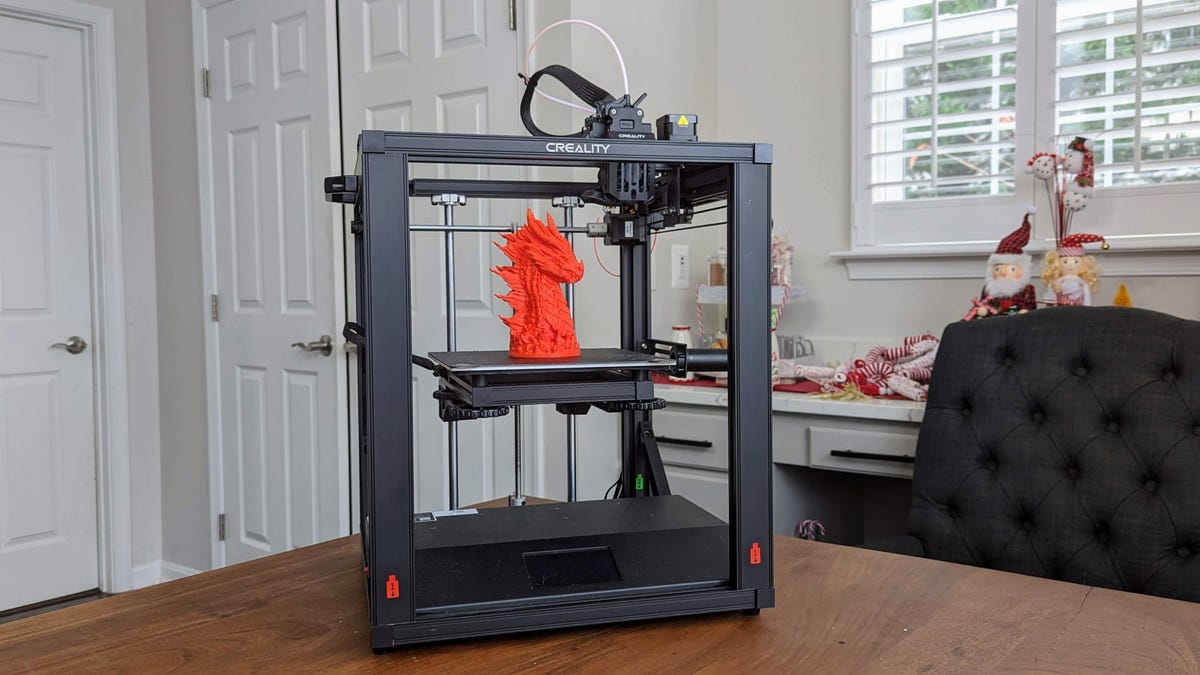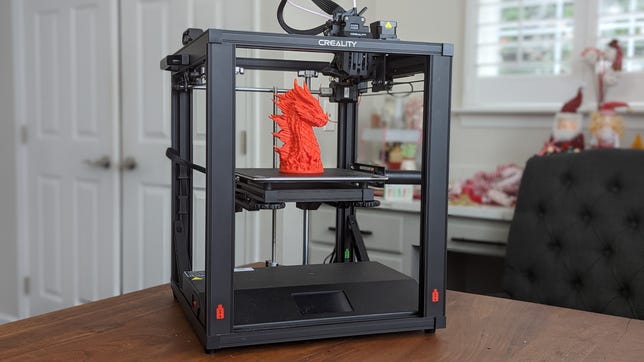Technologies
Creality Ender 5 S1 3D Printer Review: Merely Competent Among Standout Competition
A 3D printer that costs nearly $600 should really have better bed-leveling.

Despite some great innovations in 3D printing hardware and software in 2022, the new Ender 5 S1 from Creality doesn’t do much to push the envelope. It’s a decent printer, but needed more to really wow me.
Like
- Stable physical design
- Fast printing speed
- Good quality prints
Don’t Like
- Needs a lot of bed leveling
- Lackluster design
At first glance, the $579 Ender 5 S1 ticks a lot of boxes. Based on the original Ender 5 from 2019, the S1 upgrades almost every piece of hardware to make this faster and more accurate than ever before. But taking a deeper look, a lot of what we see is decidedly middle of the road.
The build quality of this 3D printer is excellent, as I’d expect from the Ender line. All of the parts look and feel well-made. When you pick it up by the built-in handles, it has a heft that suggests a ruggedness that you don’t get from cheaper models. Unlike the Ender 3, the Ender 5 is a CoreXY machine, so the bed moves up and down, rather than in and out, so it’s much more stable at high speed.
Having an all-metal hot end and an extruder assembly that is direct-drive allows the S1 to handle a variety of different materials. The direct drive extruder makes it extremely easy to print with TPU — a flexible filament you can make rubbery phone cases from — and the all-metal hot end allows high-temperature filaments like ABS and PETG to be printed, too. High temperatures can destroy the small tube in a standard hot end, which would then need to be replaced after printing PETG or ABS for long periods.
The print quality of the Ender 5 S1 is surprisingly good at the speed it prints, which is faster than many similar printers. While it says it can print at 250 millimeters per second, that doesn’t tell the whole story, as the print speed is limited in the slicer to keep the quality high. Millimeters per second is used to measure how fast the print head can move while printing, as well as when no material is being extruded. It’s an abstract number based on factory defaults, so it isn’t always accurate when you get the 3D printer to your home.
I used a spider test print from E3D, which tests overhangs and bridging — both notoriously difficult at high speed — to test the Ender 5 S1. This file takes around 1 hour, 30 minutes to print on the Prusa Mk3s, a respectable time for one of the best 3D printers right now. The Creality slicer software included with the Ender 5 S1 estimates that same print at 1 hour, 9 minutes. If it was printing at the full 250 mm/s speed, it should be three times faster than the Prusa, but it isn’t. In comparison, the AnkerMake M5 — which also touts 250 mm/s print speeds — estimates the same model to be printed in 22 minutes. So while the Ender 5 S1 is faster than most printers, it isn’t as fast as the spec sheet promises.
Limiting the speed isn’t a bad idea, per se. After all, the balance between speed and quality is important for 3D printers and the quality here is very good even on stock settings. The CNET test print showed no sign of stringing, which surprised me. Stringing occurs when there isn’t time between each layer for the plastic to cool, so it oozes out in strings. This can occur when printers are too fast, but the Ender 5 S1 did a great job with all aspects of the test print.
I printed several Fotis Mint dragons, a skeletal hand and some lobsters, and they all came out looking excellent. This FlexiFactory dinosaur looks great, and all of his articulation works as it’s supposed to, though it did take me several attempts to get the first layer to stick correctly.
The Ender 5 S1 also comes with some advanced features, such as a filament runout sensor and power-off detection, though the auto-leveling system has advantages and drawbacks.
The auto-leveling still has a manual element and requires adjustment of the bed by tuning spring-loaded height adjustment wheels underneath. This means that the 3D printer is prone to losing its bed level after a few prints. While it might not seem like a big deal to keep releveling, it can be a pain and often leads to prints failing and materials lost. It also runs counter to the entire reason for auto-leveling, the removal of human error from the equation.
A year or two ago (and maybe $100 cheaper), the Ender 5 S1 would have floored me. But in a year when we’re seeing a lot of innovation in quality, features and price, it doesn’t stand out. If you can find it on sale for less than $450 it would be worth picking up, but there are better printers, like the $569 Anycubic Kobra Max — a printer with true auto-leveling and a giant print size — or the $799 AnkerMake M5, within a stone’s throw of the Ender 5 S1’s current price of $579.
Technologies
Last Chance: Nab These RayNeo Air 3s Pro AR/XR Glasses for $249 This Cyber Monday
Level up your gaming experience with these smart glasses while they’re $50 off.

Cyber Monday is here for a few more hours, and it’s a great time to save money on the latest tech. If you’re a gamer, there are plenty of deals that’ll save you big bucks. We’ve spotted this pair of RayNeo Air 3S smart gaming glasses for just $249 at RayNeo. This saves you $50 over its usual price of $299.
These RayNeo Air 3s Pro smart gaming glasses are lightweight, include built-in speakers and spatial audio that makes your experience immersive. They’re compatible with Android, iOS and Windows operating systems and consoles such as Nintendo Switch 2.
Love playing for hours on end? These glasses are TÜV SÜD Low Blue Light & Flicker-Free certified, which essentially means they’re gentle on your eyes and can reduce strain associated with being in front of a screen. These RayNeo Air 3s smart gaming glasses are also bright enough to let you see more detail than you’d get playing on a screen.
If you use glasses you can also take the Air 3s to your optician to get prescription lenses installed for a more comfortable view.
CHEAP GAMING LAPTOP DEALS OF THE WEEK
-
$950 (save $850)
-
$800 (save $150)
Why this deal matters
These RayNeo Air 3s Pro AR/XR glasses are compatible with multiple operating systems and consoles. They offer brightness, excellent sound quality and low blue light exposure. On a typical day they cost $299, but this deal brings these smart gaming glasses down to $249. Keep in mind that this deal is live for just a few more hours.
CNET is keeping up with as many Cyber Monday deals as possible so you can make the most out of these deals while they’re still around.
Join Our Daily Deals Text Group!
Get hand-picked deals from CNET shopping experts straight to your phone.
By signing up, you confirm you are 16+ and agree to receive recurring marketing messages at the phone number provided. Consent is not a condition of purchase. Reply STOP to unsubscribe. Msg & data rates may apply. View our Privacy Policy and Terms of Use.
Technologies
Today’s NYT Mini Crossword Answers for Tuesday, Dec. 2
Here are the answers for The New York Times Mini Crossword for Dec. 2.

Looking for the most recent Mini Crossword answer? Click here for today’s Mini Crossword hints, as well as our daily answers and hints for The New York Times Wordle, Strands, Connections and Connections: Sports Edition puzzles.
Need some help with today’s Mini Crossword? It’s a fun one, especially if you like carbonated beverages, or what as a native Minnesotan, I will forever just call «pop.» Read on for the answers. And if you could use some hints and guidance for daily solving, check out our Mini Crossword tips.
If you’re looking for today’s Wordle, Connections, Connections: Sports Edition and Strands answers, you can visit CNET’s NYT puzzle hints page.
Read more: Tips and Tricks for Solving The New York Times Mini Crossword
Let’s get to those Mini Crossword clues and answers.
Mini across clues and answers
1A clue: Fittingly, the letters that bookend «Get along well»
Answer: GEL
4A clue: Coke, e.g.
Answer: DRUG
6A clue: Sprite
Answer: PIXIE
8A clue: Pepsi ___
Answer: COLA
9A clue: Subway scurrier
Answer: RAT
Mini down clues and answers
1D clue: Measure of a country’s economic output, for short
Answer: GDP
2D clue: N.Y.C. mayor Adams
Answer: ERIC
3D clue: Vegas casino shaped like a pyramid
Answer: LUXOR
5D clue: ___ monster (venomous lizard)
Answer: GILA
7D clue: Have a bite
Answer: EAT
Don’t miss any of our unbiased tech content and lab-based reviews. Add CNET as a preferred Google source.
Technologies
Samsung’s Galaxy Z TriFold Is Coming to the US Early Next Year
This triple-display foldable looks like a slim phone-tablet hybrid. It’ll first arrive in Korea later this month.

After months of teasing a triple-display foldable phone, Samsung is gearing up to launch what it’s calling the Galaxy Z TriFold — because foldables with just one hinge are so last year.
The phone is slated to become available first in Korea on Dec. 12, and will then launch in other locations including China, Taiwan, Singapore and the United Arab Emirates. It’ll arrive in the US in the first quarter of 2026.
To get this caveat out of the way: a trifold phone doesn’t actually fold three times. Rather, devices like the Z TriFold have a main screen with two hinges, allowing the phone to fold into three sections. They appear to be more of a hybrid between a phone and, when unfolded, a tablet. The Z TriFold boasts a 10-inch display when unfurled and a 6.5-inch cover display.
«The company’s decade-long experience in foldable category innovation inspired Galaxy Z TriFold’s uniquemulti-folding form factor, which uses an inward-folding design to protect the main display,» Samsung said in a blog post. «The foldingmechanism has been precisely engineered for easy opening and closing, with an auto-alarm alerting the userof incorrect folding through a series of on-screen alerts and vibrations.»
A Galaxy of features comes together
The Galaxy Z TriFold appears to borrow elements from two of its siblings: the Galaxy S25 Edge and the Galaxy Z Fold 7. Both phones are impressively thin, with the Edge measuring 5.8mm and the Z Fold 7 measuring 4.2mm thick when unfolded.
The Z TriFold goes one step further. It’s just 3.9mm thick «at its thinnest point,» Samsung says. Reading the fine print reveals that measurement excludes «the camera and the preinstalled protective film.» The thickest panel is the center one, which measures 4.2mm. The panel with the side button is 4mm thick. Still, that should all help to reduce bulk when the three screens are stacked shut on top of one another.
The rear triple-camera system includes a 200-megapixel wide-angle camera, similar to the Galaxy S25 Ultra, S25 Edge and Z Fold 7. There’s also a 12-megapixel ultrawide and 10-megapixel telephoto camera. For selfies, you’ll find 10-megapixel front-facing cameras on both the cover and main screens.
Like Samsung’s other premium phones released this year, the Z TriFold is powered by a custom Snapdragon 8 Elite processor. It also has a 5,600-mAh three-cell battery — a nice upgrade over the 4,400-mAh battery on the Galaxy Z Fold 7. Samsung notes this system «has been placed ineach of the three panels of the device for balanced power delivery and all-day endurance.» The phone supports 45-watt super-fast charging.
The Z TriFold has two different-sized hinges, «creating a smoother, more stable fold despitevarying weight and components across the device,» Samsung notes. This also helps to reduce the gap between the screens. The titanium hinge housing «resists wear over time,» and the phone’s Advanced Armor Aluminum frame should also help with durability, while preventing the screens from touching when folded shut.
The Z TriFold borrows another trait from the Z Fold 7: an IP48 rating. That means the phone can be submerged under 1.5 meters of water for up to 30 minutes and is protected against solid particles larger than 1 millimeter, but not against dust. Meanwhile, Google’s Pixel 10 Pro Fold boasts an impressive IP68 rating for water and dust resistance.
Samsung’s triple-display foldable has Corning’s Gorilla Glass Ceramic 2 on the front, while the back is made of ceramic-glass fiber-reinforced polymer.
Why would someone buy the Galaxy Z TriFold?
So what’s the point of a phone that unfolds into a giant 10-inch display? Samsung says the Z TriFold is ideal for multitasking.
«Users can use the screen with endless versatility — they can create across three different portrait-sized apps side-by-side without interruption, resize apps inmulti-window to view the most important information clearly, or hold it vertically when reviewing documents forimproved focus,» the company notes.
Samsung also says a wider screen can be good for watching movies and TV shows. And if you’re watching a YouTube video, you can simultaneously read the comments on the neighboring display. Samsung notes that «minimized creasing on the device keeps content seamless anduninterrupted.» That’ll be a crucial element.
The phone’s AMOLED cover and main screens have a refresh rate up to 120Hz. The cover display boasts 2,600 nits of peak brightness, while the main screen features a peak brightness of 1,600 nits.
The Galaxy Z TriFold will arrive with Android 16 and One UI 8. It’s not clear how much the phone will cost, but given the Z Fold 7’s $2,000 starting price, it’ll probably be a pretty penny.
-

 Technologies3 года ago
Technologies3 года agoTech Companies Need to Be Held Accountable for Security, Experts Say
-

 Technologies3 года ago
Technologies3 года agoBest Handheld Game Console in 2023
-

 Technologies3 года ago
Technologies3 года agoTighten Up Your VR Game With the Best Head Straps for Quest 2
-

 Technologies4 года ago
Technologies4 года agoBlack Friday 2021: The best deals on TVs, headphones, kitchenware, and more
-

 Technologies4 года ago
Technologies4 года agoVerum, Wickr and Threema: next generation secured messengers
-

 Technologies4 года ago
Technologies4 года agoGoogle to require vaccinations as Silicon Valley rethinks return-to-office policies
-

 Technologies4 года ago
Technologies4 года agoOlivia Harlan Dekker for Verum Messenger
-

 Technologies4 года ago
Technologies4 года agoiPhone 13 event: How to watch Apple’s big announcement tomorrow

